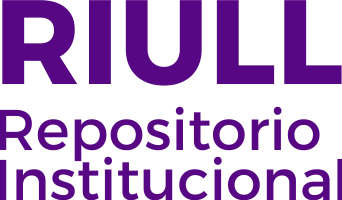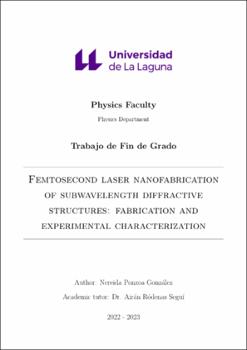Femtosecond laser nanofabrication of subwavelength diffractive structures: fabrication and experimental characterization
Author
Ponzoa Gonzàlez, NereidaDate
2023Abstract
In the present work, diffraction gratings will be fabricated using a relatively recent method
called 3D nanolithography. This consists of, by means of a femtosecond laser, engraving on a
crystal the structure we want. This crystal is then subjected to a wet chemical etch leaving pores
in the crystal in the form of the previously engraved structure. In our case, being a diffraction
grating, we will engrave horizontal lines on the crystal. We want to obtain a diffraction grating
whose efficiency in the first order of diffraction is almost 100%, for this we will be based on
various works already done to choose the manufacturing parameters. A total of two diffraction
gratings have been made, both with grating parameter Λ = 0.0005mm and with a repetition
rate of 1MHz (pulses per second). In the first one its scan speed has been 10 mm
s
, overwriting
has been performed and 5 powers have been used: 22, 19, 16, 13 and 10 mW. For the second of
the fabrications, a scan rate of 1 mm
s was used and 6 powers were selected: 22, 20, 18, 16, 14 and
12 mW. The first of the fabrications did not come out as expected for two reasons, firstly only
fragments from 3 of the 5 powers were etched and secondly many nanocracks were generated
during engraving; for these reasons not many results could be extracted.
The first of the results that we have been able to observe is an anisotropic shift when the lattice
is engraved, as it only transmits vertically polarized light. We have also seen that for the higher
powers the crystal starts attacking faster, but that these end up reaching modification saturation
much earlier than the lower powers. We have fitted the data from the second of the fabrications
to a diffusion function, obtaining which type of diffusion follows the chemical attack inside the
pores as a function of power. We have concluded that at the beginning all the powers follow a
Brownian diffusion, and afterwards the more intense powers become subdiffusive and the less
intense ones a superdiffusive diffusion. Finally, we mention some of the improvements that can
be made in the experiments and some projects that we want to carry out in the future. En el presente trabajo se van a fabricar redes de difracci´on mediante un m´etodo relativamente
reciente llamado nanolitografia 3D. Este consiste en, mediante un l´aser de femtosegundos,
grabar sobre un cristal la estructura que queramos. Despu´es este cristal ser´a sometido a ataque
qu´ımico, dejando poros en el cristal en forma de la estructura previamente grabada. En nuestro
caso, al tratarse se una red de difracci´on, grabaremos l´ıneas horizontales en el cristal. Queremos
lograr obtener una red de difracci´on cuya eficiencia en el primer orden de difracci´on sea casi del
100%, para ello nos basaremos en distintos trabajos ya realizados para elegir los par´ametros
de fabricaci´on. Se han hecho un total de dos redes de difracci´on, ambas con par´ametro de red
Λ = 0.0005mm y con una tasa de repetici´on de 1MHz (pulsos por segundo). En la primera de
ellas su velocidad de escaneo ha sido de 10 mm
s
, se ha realizado sobrescritura y se han utilizado 5
potencias: 22, 19, 16, 13 y 10 mW. Para la segunda de las fabricaciones se utiliz´o una velocidad
de escaneo de 1mm
s
y se seleccionaron 6 potencias: 22, 20, 18, 16, 14 y 12 mW. La primera de
las fabricaciones no sali´o como se esperaba por dos motivos, en primer lugar solo se grabaron
fragmentos de 3 de las 5 potencias y en segundo lugar se generaron muchos nanocracks durante
el grabado; por estos motivos no se pudieron extraer muchos resultados.
El primero de los resultados que hemos podido observar es un cambio anis´otropo al grabar la red,
pues solo transmite luz polarizada verticalmente. Tambi´en hemos visto que para las potencias
m´as altas el cristal se empieza atacando con m´as velocidad, pero que estas acaban llegando a la
saturaci´on de modificaci´on mucho antes que las potencias menores. Hemos ajustado los datos
de la segunda de las fabricaciones a una funci´on de difusi´on, obteniendo que tipo de difusi´on
sigue el ataque qu´ımico dentro de los poros en funci´on de la potencia. Hemos concluido que al
principio todas las potencias siguen una difusi´on Browniana, y que despu´es las potencias m´as
intensas pasan a tener una difusi´on subdifusiva y las menos intensas una superdifusiva. Para
finalizar, se mencionan algunas de las mejoras que se pueden realizar en los experimentos y
algunos proyectos que se quieren realizar en un futuro.




